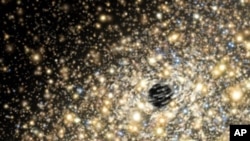U.S.-based astronomers have discovered the two largest supermassive black holes ever detected which may provide new insights into the early universe.
The University of California, Berkeley, scientists say each of the supermassive black holes has a mass equivalent of 10 billion times the mass of the Sun, or solar mass, and a gravitation pull covering a region five times the size of our solar system. Previously, the heftiest supermassive black hole ever observed weighed in at 6.3 solar masses.
Most astronomers generally agree there is a black hole located at the center of most, if not all, galaxies in the universe - including a dormant giant sitting at the heart of our own Milky Way galaxy. Scientists call this type of black hole a supermassive black hole.
The U.C. Berkeley researchers say each of the newly-discovered supermassive black holes sits at the center an enormous elliptical galaxy more than 300 million light years from the Earth. They believe the giant galaxies and their black holes were formed from the collision of two or more spiral galaxies some 10 billion years ago.
This early period in the universe’s development is when a rarely-seen type of brightly blazing galaxy known as a quasar was common. The astronomers say the two supermassive black holes may be dark remnants of quasars.
The new study is published in this week's edition of the journal, Nature.
Quasars are most commonly seen in observations of the early universe, but rarely at later periods.
The dense mass of a supermassive black hole is millions of times greater than that of our Sun. A black hole’s inescapable gravitational forces can capture anything from subatomic particles to massive stars. At near light speed, the material is pulled apart and swirled around the black hole opening before disappearing into the void. Nothing, not even light, can escape the powerful gravitational forces of a black hole.
The universe is thought to be 13.7 billion years ago, while our solar system formed with the birth of the Sun 4.6 billion years ago. A light-year is how far light can travel through the vacuum of outer space in one year, a distance of approximately 10 trillion kilometers.
Supermassive Black Holes Biggest Ever Found









